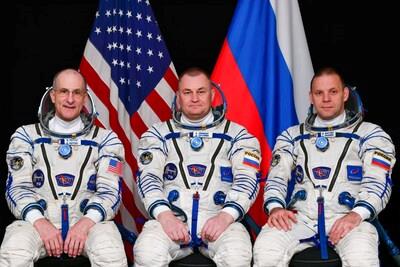(MENAFN- PR Newswire)
WASHINGTON, Sept. 6, 2024 /PRNewswire/ -- NASA astronaut Don
Pettit will launch aboard the Roscosmos Soyuz MS-26 spacecraft, accompanied by cosmonauts Alexey Ovchinin and Ivan Vagner, to the International Space Station where they will join the Expedition 71 crew in advancing scientific research.
Pettit, Ovchinin, and Vagner will lift off at 12:23 p.m. EDT Wednesday, Sept. 11 (9:23 p.m. Baikonur time) from the Baikonur Cosmodrome in Kazakhstan.
Continue Reading

The Roscosmos Soyuz MS-26 spacecraft will launch from the Baikonur Cosmodrome in Kazakhstan to the International Space Station with (pictured left to right) NASA astronaut Don Pettit and Roscosmos cosmonauts Alexey Ovchinin and Ivan Vagner. Credit: Gagarin Cosmonaut Training Center
Coverage will stream on NASA+ , the NASA app , and the agency's website . Learn how to stream NASA content through a variety of platforms including social media.
After a two-orbit, three-hour trajectory to the station, the spacecraft will automatically dock at 3:33 p.m. at the orbiting laboratory's Rassvet module. Shortly after, hatches will open between the spacecraft and the station.
Once aboard, the trio will join NASA astronauts Tracy C. Dyson, Mike Barratt, Matthew Dominick, Jeanette Epps, Butch Wilmore, and Suni Williams, as well as Roscosmos cosmonauts Nikolai Chub, Alexander Grebenkin, and Oleg Kononenko.
NASA's coverage is as follows (all times Eastern and subject to change based on real-time operations):
11:15 a.m. – Launch coverage begins on NASA +, the NASA app , YouTube , and the agency's website .
12:23
p.m. – Launch
2:30 p.m. – Rendezvous and docking coverage begins on NASA+ , the NASA app , YouTube , and the agency's website .
3:33 p.m. – Docking
5:30 p.m. – Hatch opening and welcome remarks coverage begins on NASA+ , the NASA app , YouTube , and the agency's website .
5:50
p.m. – Hatch opening
The trio will spend approximately six months aboard the orbital laboratory as Expedition 71 and 72 crew members before returning to Earth in the spring of 2025. This will be the fourth spaceflight for Pettit and Ovchinin, and the second for Vagner.
For more than two decades, people have lived and worked continuously aboard the International Space Station, advancing scientific knowledge, and making research breakthroughs that are not possible on Earth. The station is a critical testbed for NASA to understand and overcome the challenges of long-duration spaceflight and to expand commercial opportunities in low Earth orbit. As commercial companies focus on providing human space transportation services and destinations as part of a robust
low Earth orbit economy , NASA is focusing more resources on deep space missions to the Moon as part of Artemis in preparation for future human missions to Mars.
Learn more about International Space Station research and operations at:
SOURCE NASA
MENAFN06092024003732001241ID1108645582
Legal Disclaimer:
MENAFN provides the information “as is” without warranty of any kind. We do not accept any responsibility or liability for the accuracy, content, images, videos, licenses, completeness, legality, or reliability of the information contained in this article. If you have any complaints or copyright issues related to this article, kindly contact the provider above.